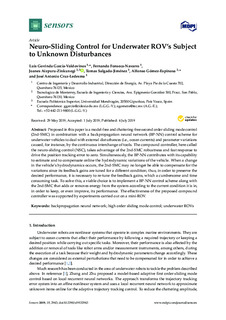| dc.rights.license | Attribution 4.0 International | * |
| dc.contributor.author | Aizpuru Zinkunegi, Joanes | |
| dc.contributor.other | Govinda García-Valdovinos, Luis | |
| dc.contributor.other | Fonseca-Navarro, Fernando | |
| dc.contributor.other | Salgado Jiménez, Tomas | |
| dc.contributor.other | Gómez Espinosa, Alfonso | |
| dc.contributor.other | Cruz Ledesma, José Antonio | |
| dc.date.accessioned | 2020-05-29T09:14:00Z | |
| dc.date.available | 2020-05-29T09:14:00Z | |
| dc.date.issued | 2019 | |
| dc.identifier.issn | 1424-8220 | en |
| dc.identifier.other | https://katalogoa.mondragon.edu/janium-bin/janium_login_opac.pl?find&ficha_no=153447 | en |
| dc.identifier.uri | https://hdl.handle.net/20.500.11984/1673 | |
| dc.description.abstract | Proposed in this paper is a model-free and chattering-free second order sliding mode control(2nd-SMC) in combination with a backpropagation neural network (BP-NN) control scheme for underwater vehicles to deal with external disturbances (i.e., ocean currents) and parameter variations caused, for instance, by the continuous interchange of tools. The compound controller, here called the neuro-sliding control (NSC), takes advantage of the 2nd-SMC robustness and fast response to drive the position tracking error to zero. Simultaneously, the BP-NN contributes with its capability to estimate and to compensate online the hydrodynamic variations of the vehicle. When a change in the vehicle’s hydrodynamics occurs, the 2nd-SMC may no longer be able to compensate for the variations since its feedback gains are tuned for a di erent condition; thus, in order to preserve the desired performance, it is necessary to re-tune the feedback gains, which a cumbersome and time consuming task. To solve this, a viable choice is to implement a BP-NN control scheme along with the 2nd-SMC that adds or removes energy from the system according to the current condition it is in, in order to keep, or even improve, its performance. The e ectiveness of the proposed compound controller was supported by experiments carried out on a mini-ROV. | en |
| dc.description.sponsorship | Financiado por SENER-CONACyT | es |
| dc.language.iso | eng | en |
| dc.publisher | MDPI | en |
| dc.rights | © 2019 by the authors. Licensee MDPI, Basel, Switzerland | en |
| dc.rights.uri | http://creativecommons.org/licenses/by/4.0/ | * |
| dc.subject | Backpropagation neural network | en |
| dc.subject | High order sliding mode control | en |
| dc.subject | Underwater ROVs | en |
| dc.title | Neuro-Sliding Control for Underwater ROV’s Subject to Unknown Disturbances | en |
| dcterms.accessRights | http://purl.org/coar/access_right/c_abf2 | en |
| dcterms.source | Sensors | en |
| local.description.peerreviewed | true | en |
| local.identifier.doi | https://doi.org/10.3390/s19132943 | en |
| local.relation.projectID | Hydrocarbons Sectorial Fund 201.441. Implementation of oceanographic observation networks (physical, geochemical, ecological) for generating scenarios of possible contingencies related to the exploration and production of hydrocarbons in the deepwater Gulf of Mexico | en |
| local.rights.publicationfee | APC | en |
| local.rights.publicationfeeamount | 1870 € | en |
| local.contributor.otherinstitution | https://ror.org/03ayjn504 | es |
| local.contributor.otherinstitution | https://ror.org/03cf87p34 | es |
| local.source.details | Vol. 19. Nº 13. 2943. July, 2019 | eu_ES |
| oaire.format.mimetype | application/pdf | |
| oaire.file | $DSPACE\assetstore | |
| oaire.resourceType | http://purl.org/coar/resource_type/c_6501 | en |
| oaire.version | http://purl.org/coar/version/c_970fb48d4fbd8a85 | en |








